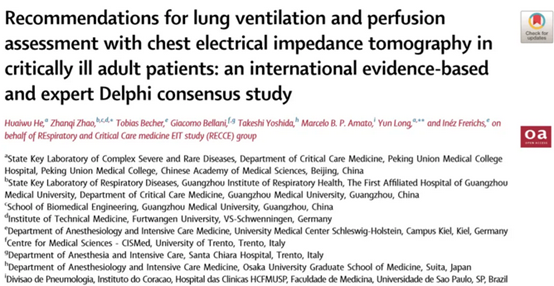Recently, Deputy Director He Huaiwu and Director Long Yun from the Department of Critical Care Medicine at PUMCH, in collaboration with Professor Zhao Zhanqi from the School of Biomedical Engineering, Guangzhou Medical University, led the development of the first international evidence-based expert consensus on the application of electrical impedance tomography (EIT) in critically ill adult patients. This consensus serves as important reference and guidelines for the global clinical application of chest EIT. The findings were published in The Lancet sub-journal EClinicalMedicine (a Tier 1 journal, or among the top 5% as ranked by the Chinese Academy of Sciences; IF: 10.52). This study was supported by the National High-Level Hospital Clinical Research Funding, the National Key Research and Development Program, and the National Natural Science Foundation of China.

EIT can capture dynamic changes in lung ventilation and perfusion in real time at the bedside. As a non-invasive imaging technique, it effectively avoids radiation exposure from CT scans and the risks associated with transporting critically ill patients. In recent years, its clinical application has become increasingly widespread. However, there is a global lack of evidence-based recommendations for the clinical application of EIT, with inconsistent operational standards across different medical centers, which has prevented the technology from reaching its full potential.
To address this gap, Chinese experts led an initiative in 2022 to convene international experts from multiple countries, assembling a multidisciplinary team including specialists in critical care, respiratory medicine, biomedical engineering, and evidence-based guideline methodology. The team identified 14 key questions regarding data acquisition and analysis, clinical application indications, and future development directions for chest EIT in adult critically ill patients. A systematic search was conducted of 11,159 publications indexed in four major databases (including MEDLINE and EMBASE) from 1990 to March 2024, from which 242 studies were reviewed to extract evidence. Through two rounds of Delphi surveys, 20 international experts from 12 countries ultimately reached consensus on 85 recommendations.
Regarding data acquisition, the consensus clearly defined the standard placement position for the EIT electrode belt and emphasized that reports must specify the anatomical location of electrode placement to ensure data comparability. For data interpretation, the consensus standardized analytical methods for key parameters. Taking end-expiratory lung impedance (EELI) as an example, experts unanimously agreed that clinical practice should focus on trends in EELI changes. In clinical applications, EIT demonstrates multifaceted value. In diagnosing the etiology of respiratory failure, EIT can identify causes such as pneumothorax and pleural effusion through characteristic regional impedance changes. By implementing contrast-enhanced EIT, bedside assessment of lung perfusion and V/Q match can be achieved, helping physicians rapidly screen etiologies and guide treatment. In respiratory management, EIT can guide individualized PEEP settings during mechanical ventilation to reduce the risk of ventilator-associated lung injury.
In addition, EIT can be used to assess lung ventilation changes during spontaneous breathing trials to guide weaning; quantitatively evaluate the effects of prone positioning on ventilation, perfusion, and V/Q match; detect the presence of pendelluft to identify patient self-inflicted lung injury; monitor regional ventilation changes to guide early activity, airway clearance, pulmonary physiotherapy, and personalized rehabilitation in critically ill patients; and help individualized PEEP and tidal volume settings during extracorporeal membrane oxygenation therapy.
The consensus also highlighted current limitations in EIT application. Experts have not yet reached consensus on perfusion assessment with heart-beat related EIT signal or calculation of regional ventilation delay, warranting more high-quality research for further validation.
Written by the Department of Critical Care Medicine and the Publicity Department
Edited by Gan Dingzhu and Chen Xiao
Chief Editor Duan Wenli
Supervised by Wu Peixin
